PART - 1 Python Introduction- Variables- Data types - Numeric- String- Boolean.pptx.pdf
- 1. ASHA NIVEDITHA SOFTWARE TECHNICAL TRAINER
- 3. PROGRAMMING LANGUAGE •A programming language is a type of written language that tells computers what to do. •A "program" in general, is a sequence of instructions written so that a computer can perform certain task.
- 5. Types of programming languages The programming languages are broadly classified into three types, • Low-level language • High-level language • Middle-level language
- 6. Low-level langu age It is machine-dependent. It works based on the binary number 0’s and 1’s. The processor runs low-level programs directly without the need of a compiler or interpreter so the program written in low-level language can be run very fast.
- 7. High-level programming language High-level programming language (HLL) is designed for developing user-friendly software programs and websites. This programming language requires a compiler or interpreter to translate the program into machine language (execute the program). Example: Python, Java, JavaScript, PHP, C#, C++, etc.
- 8. Middle-level programming language Middle-level programming language lies between the low-level programming language and the high-level programming language. It is also known as the intermediate programming language and pseudo-language. A middle-level programming language's advantages are that it supports the features of high-level programming, it is a user-friendly language, and is closely related to machine language and human language. Example: C, C++, language
- 9. PYTHON Interpreted programming language Dynamic Object Oriented Versatile scripting language Multiple programming paradigms.
- 10. PROGRAMMING VS SCRIPTING Scripts are few lines of code used within a program. These scripts are written to automate some particular tasks within the program. Programming languages are a set of code/instructions for the computer that are compiled at runtime. Thus an exe file is created
- 11. Advantages and Disadvantages of Python
- 12. HISTORY Python was created by Guido van Rossum, and first released on February 20, 1991. While you may know the python as a large snake, the name of the Python programming language comes from an old BBC television comedy sketch series called Monty Python's Flying Circus.
- 15. FEATURES Easy to read and learn Free and Open source Cross platform Large standard library Extensible GUI Programming support
- 16. APPLICATIONS Web applications GUI based desktop applications(Games, Scientific Applications) Operating Systems Enterprise and Business applications Audio or video based applications 3D CAD application
- 17. SCOPE OF PYTHON
- 18. DOWNLOADING AND INSTALLATION Visit the link https://www.python.org
- 19. Ways to run Python Scripts 1. Command Line [python script.py] ✔ Open a terminal or command prompt. ✔ Navigate to the directory containing your Python script using the cd command. 2. IDLE (Python's Integrated Development and Learning Environment): ✔ Open IDLE and use the "File" menu to open your script, then run it. 3. Jupyter Notebooks [Using interpreter interactively] ✔ If you are using Jupyter Notebooks, you can run individual cells or the entire notebook. ✔ Use the "Run" button or press Shift + Enter to execute a cell.
- 20. IDE An integrated development environment (IDE) is a software application that helps programmers develop software code efficiently. It increases developer productivity by combining capabilities such as software editing, building, testing, and packaging in an easy-to-use application.
- 21. ANACONDA PYTHON Anaconda is a distribution of the Python and R programming languages for scientific computing (data science, machine learning applications, large-scale data processing, predictive analytics, etc.), that aims to simplify package management and deployment.
- 24. VARIABLE • In Python, variables are a storage placeholder for texts and numbers. • It must have a name so that you are able to find it again • The variable is always assigned with the equal sign, followed by the value of the variable. • A variable is created the moment we first assign a value to it. Example: a=10 b=“IBM” print(a) Print(b)
- 25. RULES FOR CREATING VARIABLES Must start with a letter or the underscore character Cannot start with a number Can only contain alpha-numeric characters and underscores (A-z, 0-9, and _ ) Case-sensitive (name, Name and NAME are three different variables) The reserved words(keywords) cannot be used naming the variable
- 26. Assigning a single value to multiple variables Example:: x=y=z= 100 print(x) print(y) print(z)
- 27. Assigning different values to multiple variables Example: x, y, z =10, 20.20, “IBM CE” print(x) print(y) print(z)
- 28. Can we use same name for different types? If we use same name, the variable starts referring to new value and type. Example: x=23 x=“salary” print(x)
- 29. How does + operator work with variables Example: x = 100 y = 200 print(x + y) x = "IBM" y = "CE" print(x + y)
- 30. Can we use + for different types also? ‘+’ used for adding different data types will produce an error. Example: age= 10 name = "David" print(age+name) OUTPUT: TypeError: unsupported operand type(s) for +: 'int' and 'str'
- 31. Keywords •Keywords are special reserved words which convey a special meaning to the compiler/interpreter. •Each keyword have a special meaning and a specific operation. import keyword print(keyword.kwlist)
- 33. IO OPERATIONS •print( ) - Used for output operation •input( ) - Used for input operations. name = input() number = int(input()) print ('my name is:’, name, 'and my age is:', number)
- 34. Data types
- 35. DATA TYPES Immutable Data Types Numeric types(int, float, complex) Tuple String and Boolean Mutable Data Types List Dictionary Set
- 36. Data Types:- Variables will hold values, and every value has its own data-type. Python is a dynamically typed language Hence we do not need to define the type of the variable while declaring it. The interpreter implicitly binds the value with its type.
- 37. a = 5 The variable a holds integer value five and we did not define its type. Python interpreter will automatically interpret variables a as an integer type. Python enables us to check the type of the variable used in the program. Python provides us the type() function, which returns the type of the variable passed.
- 38. Numeric Datatype :- Numeric values are known as numbers. There are three types. integer, float, and complex (They may be +ve /-ve) Python provides the type() function to know the data-type of the variable.
- 39. Example: Output: x=1 #integer <Class ‘int’> y=13.6 #float <Class ‘float’> z=6+1j #complex <Class ‘complex’> print(type(x)) print(type(y)) print(type(z))
- 40. Comments Helps explaining Python code. make the code more readable. prevent execution when testing code. Comments starts with a #, and Python will ignore them
- 41. Constants A constant is a special type of variable whose value cannot be changed. import constant print(constant.PI) # prints 3.14 print(constant.GRAVITY) # prints 9.8
- 42. Type Conversion:- #convert from int to float: x = 1 a = float(x) print(a) #convert from float to int: y = 2.8 b = int(y) print(b) #convert from int to complex: z = 1 c = complex(z) print(c)
- 43. Points to Remember:- All the keywords must be used as they have defined. (Uppercase and Lower Case) Keywords should not be used as identifiers like variable names, functions name, class name, etc. The meaning of each keyword is fixed, we can not modify or remove it.
- 44. Booleans Booleans represent one of two values: True or False. Input: Output: print(10 > 9) True print(10 == 9) False
- 45. Strings String is a sequence of characters. String may contain alphabets, numbers and special characters. Usually strings are enclosed within a single quotes and double quotes. Example: a= “hello world‟ b= ‘Python’ We can display a string literal with the print() function.
- 46. Example 1: String1 ="I'm a technical lead" print(String1) Example 2 : String2 ='I'm a technical lead’ print(String2) Example 3: String3 ='''I'm a technical lead and “tester”"' print(String3) Example 4: String4 =‘‘‘python for datascience ”’ print(String4)
- 47. OUTPUT for Example 1: I'm a technical lead OUTPUT for Example 2: SyntaxError: invalid syntax OUTPUT for Example 3: I'm a technical lead and "tester" OUTPUT for Example 4: python for datascience
- 48. Multiline Strings We can assign a multiline string to a variable by using three quotes. a = ""“You get What you work for Not what you wish for.""" print(a)
- 49. Strings in Python are arrays of bytes representing unicode characters. Python does not have a character data type, a single character is simply a string with a length of 1. Square brackets can be used to access elements of the string. Indexing:- a = "Hello, World!" print(a[1])
- 50. Accessing characters in Python Individual characters of a String can be accessed by using the method of Indexing. To access a range of characters in the String, method of slicing is used.( done by using a Slicing operator (colon)).
- 51. Strings indexing and splitting The indexing of the python strings starts from 0.
- 52. b = "Hello, World!" print(b[3:-5]) Slicing:- b = "Hello,World!" print(b[2:5]) b = "Hello,World!" print(b[:5]) b = "Hello,World!" print(b[2:])
- 54. Deleting/Updating from a String Updation or deletion of characters from a String is not allowed. This will cause an error because item assignment or item deletion from a String is not supported. Although deletion of entire String is possible with the use of a built-in del keyword. This is because Strings are immutable, hence elements of a String cannot be changed once it has been assigned. Only new strings can be reassigned to the same name.
- 55. Deleting Entire String:(using del keyword) Example: String1 = "Hello, I'm john" print(String1) # Deleting entire String del String1 print("nDeleting the entire string ") print(String1)
- 56. OUTPUT: Hello, I'm john Deleting the entire string NameError: name 'String1' is not defined
- 57. Find the output str1="IBM" print(str1[5]) print(str1) OUTPUT: IndexError: string index out of range IBM
- 58. NOTE ✔ While accessing an index out of the range will cause an Index Error. ✔ Only Integers are allowed to be passed as an index, float or other types will cause a TypeError.
- 59. String operations Concatenation of Two or More Strings Removes any whitespace from the beginning or the end The length of a string Strings in lower case Strings in upper case Replaces a string with another string Splits the string into substrings
- 60. Concatenation of Two or More Strings Joining of two or more strings into a single one is called concatenation. Example: str1 = "python" str2 ="programming" # using + print("str1 + str2 = ", str1 + str2) OUTPUT: str1 + str2 = pythonprogramming
- 61. Example: str1 = "python" # using * print('str1 * 3 =', str1 * 3) OUTPUT: str1 * 3 = pythonpythonpython
- 62. Removes any whitespace from the beginning or the end Example: A = “ Hello, World! ” print(A) a = " Hello, World! “ print(a.strip()) OUTPUT: Hello, World! Hello, World!
- 63. To find the the length of a string Example: a = "Hello, World!" print(len(a)) OUTPUT: 13
- 64. Strings in lower case Example: a = "HELLO, World!" print(a.lower()) OUTPUT: hello, world!
- 65. Strings in upper case Example: a = "Hello, World!" print(a.upper()) OUTPUT: HELLO, WORLD!
- 66. Replaces a string with another string Example: a = "Hello, World!" print(a.replace("H", “F")) OUTPUT: Fello, World!
- 67. Splits the string into substrings Example: a = "Hello, World!" print(a.split(",")) OUTPUT: ['Hello', ' World!']
- 68. String Methods In Python:-
- 69. String Methods In Python:-
- 70. String Methods In Python:-
- 71. String Methods In Python:-
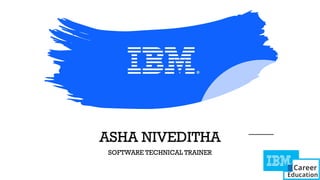
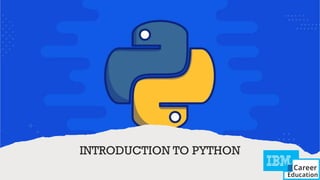
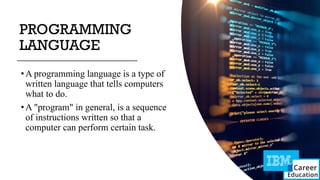
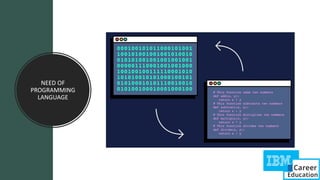
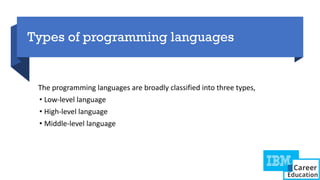
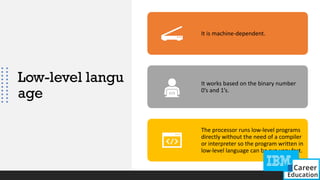

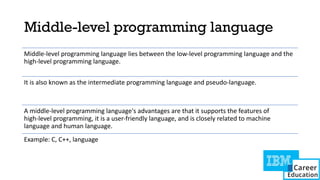


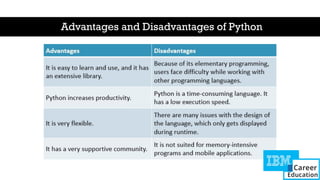

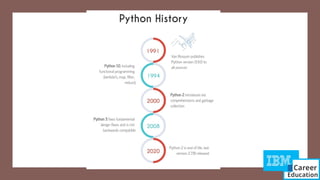
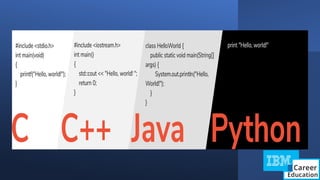




![Ways to run Python Scripts
1. Command Line [python script.py]
✔ Open a terminal or command prompt.
✔ Navigate to the directory containing your Python script using the cd command.
2. IDLE (Python's Integrated Development and Learning Environment):
✔ Open IDLE and use the "File" menu to open your script, then run it.
3. Jupyter Notebooks [Using interpreter interactively]
✔ If you are using Jupyter Notebooks, you can run individual cells or the entire notebook.
✔ Use the "Run" button or press Shift + Enter to execute a cell.](https://image.slidesharecdn.com/part-1pythonintroduction-variables-datatypes-numeric-string-boolean-240304050441-b7f10370/85/PART-1-Python-Introduction-Variables-Data-types-Numeric-String-Boolean-pptx-pdf-19-320.jpg)
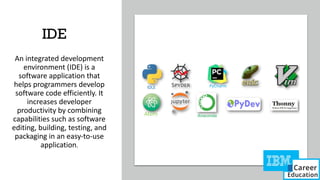

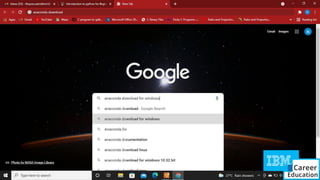
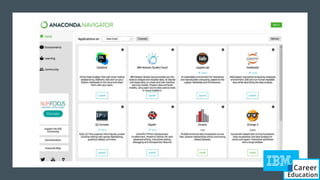
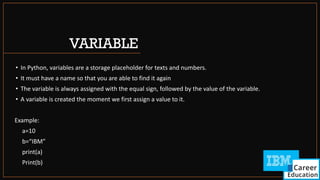


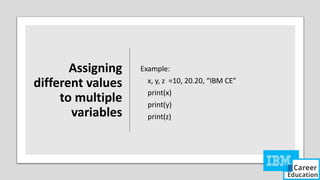
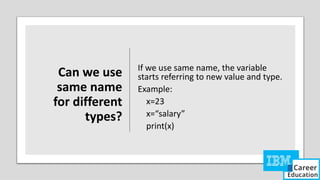

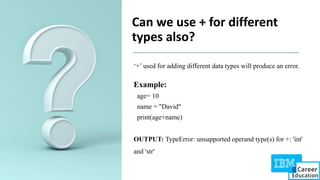

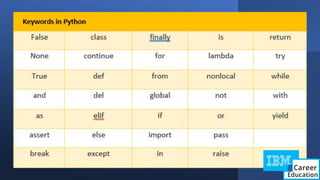



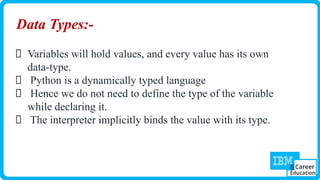
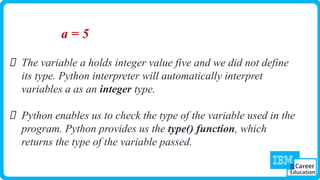
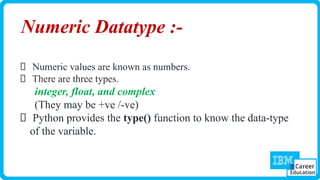

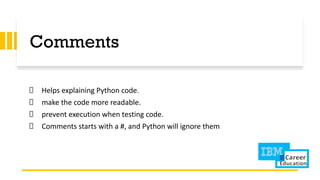
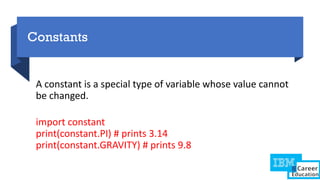
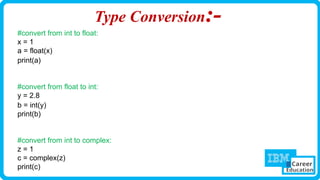
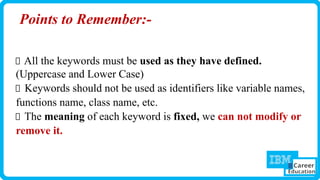
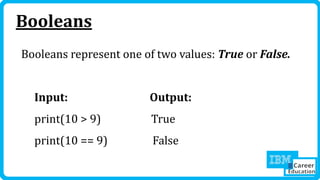
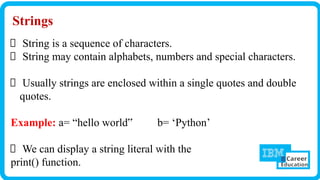
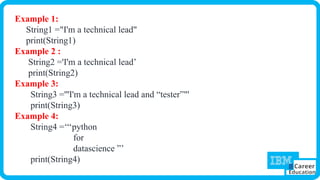
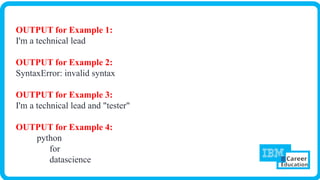
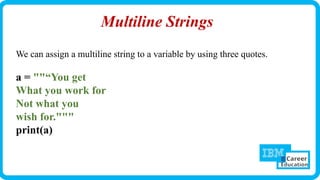
![Strings in Python are arrays of bytes representing unicode characters.
Python does not have a character data type, a single character is simply a
string with a length of 1.
Square brackets can be used to access elements of the string.
Indexing:-
a = "Hello, World!"
print(a[1])](https://image.slidesharecdn.com/part-1pythonintroduction-variables-datatypes-numeric-string-boolean-240304050441-b7f10370/85/PART-1-Python-Introduction-Variables-Data-types-Numeric-String-Boolean-pptx-pdf-49-320.jpg)
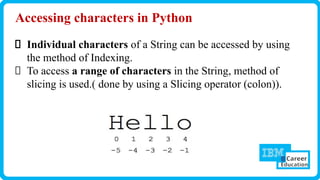
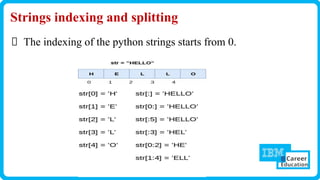
![b = "Hello, World!"
print(b[3:-5])
Slicing:-
b = "Hello,World!"
print(b[2:5])
b = "Hello,World!"
print(b[:5])
b = "Hello,World!"
print(b[2:])](https://image.slidesharecdn.com/part-1pythonintroduction-variables-datatypes-numeric-string-boolean-240304050441-b7f10370/85/PART-1-Python-Introduction-Variables-Data-types-Numeric-String-Boolean-pptx-pdf-52-320.jpg)
![Output:
b="hello,world!"
print(b)
print(b[2:5])
print(b[2:])
print(b[:5])
print(b[3:-5])
hello,world!
llo
llo,world!
hello
lo,w](https://image.slidesharecdn.com/part-1pythonintroduction-variables-datatypes-numeric-string-boolean-240304050441-b7f10370/85/PART-1-Python-Introduction-Variables-Data-types-Numeric-String-Boolean-pptx-pdf-53-320.jpg)
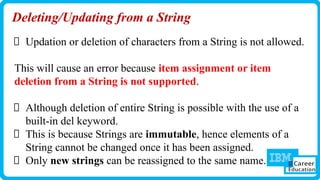

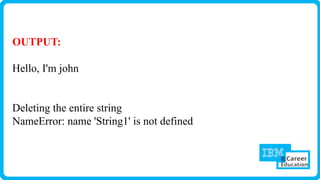
![Find the output
str1="IBM"
print(str1[5])
print(str1)
OUTPUT:
IndexError: string index out of range
IBM](https://image.slidesharecdn.com/part-1pythonintroduction-variables-datatypes-numeric-string-boolean-240304050441-b7f10370/85/PART-1-Python-Introduction-Variables-Data-types-Numeric-String-Boolean-pptx-pdf-57-320.jpg)
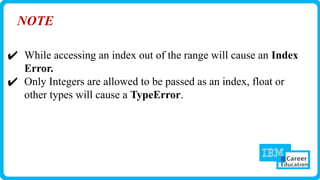

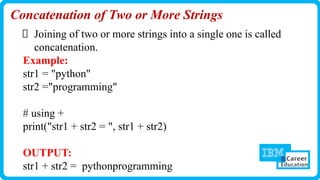
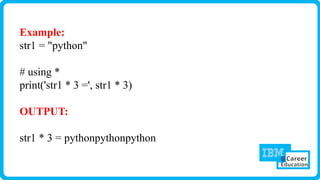
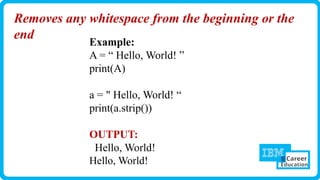
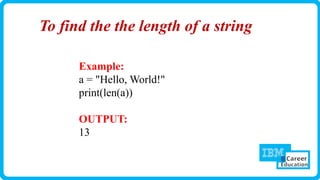
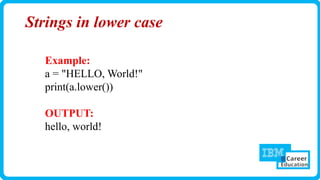
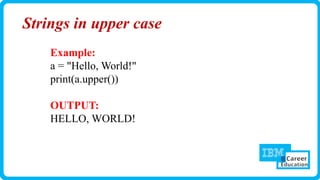
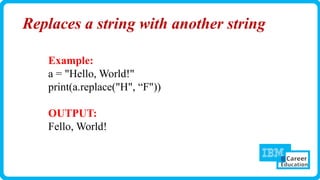
![Splits the string into substrings
Example:
a = "Hello, World!"
print(a.split(","))
OUTPUT:
['Hello', ' World!']](https://image.slidesharecdn.com/part-1pythonintroduction-variables-datatypes-numeric-string-boolean-240304050441-b7f10370/85/PART-1-Python-Introduction-Variables-Data-types-Numeric-String-Boolean-pptx-pdf-67-320.jpg)


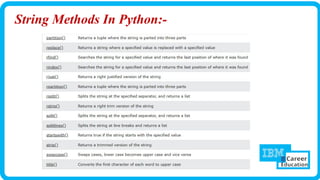
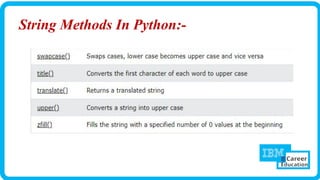









































![[Eddie Lee] Capstone Project - AI PM Bootcamp - DataFox.pdf](https://cdn.slidesharecdn.com/ss_thumbnails/eddieleecapstoneproject-aipmbootcamp-datafox-250607001838-bf03fa6b-thumbnail.jpg?width=560&fit=bounds)





